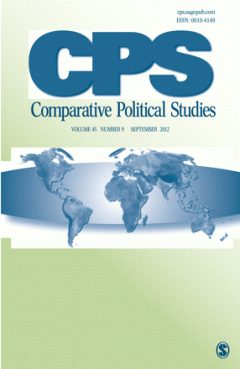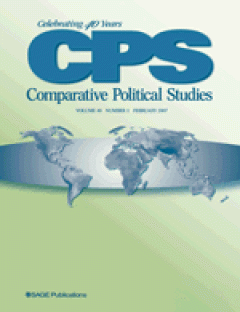Filter by

The Power Knocks at the Courts' Back Door: Two Waves of Postcommunist Judicia…
In the postcommunist countries' candidate to the European membership, the EU and the Council of Europe exercised a heavy pressure on domestic elite to promote the adoption of institutional guarantees of judicial independence and judicial capacity. Relying on a wide set of interviews with the key actors of the European and domestic institutions, this article will discuss the logic of action of t…
- Edition
- Volume 42, Number 6, June 2009. pp. 816-840
- ISBN/ISSN
- 0010-4140
- Collation
- -
- Series Title
- Comparative Political Studies
- Call Number
- -

Candidate Selection Procedures, Seniority, and Vote-Seeking Behavior
It has been argued that inclusive and decentralized selection procedures create greater incentives for parliamentarians to enhance their personal reputations. However, while the observable implications of this theory are at the level of individual members, the empirical data often brought to bear on this question to date have been collected at an aggregate level�the partisan bloc or legislative…
- Edition
- Volume 42, Number 7, July 2009. pp. 945-970
- ISBN/ISSN
- 00104140
- Collation
- -
- Series Title
- Comparative Political Studies
- Call Number
- -

Europeanization, Education, and School Curricula: The Role of Historical Lega…
One might expect governments to react to deepening European integration since the mid-1980s by updating national school curricula in social science subjects such as history and geography so as to reflect the new realities. France has done so, whereas England has not. This study asks how one explains this variation in outcome. Established explanations for why Britain has been a more reluctant Eu…
- Edition
- Volume 42, Number 7, July 2009. pp. 916-944
- ISBN/ISSN
- 0010-4140
- Collation
- -
- Series Title
- Comparative Political Studies
- Call Number
- -

Risks and Redistribution: An Individual-Level Analysis
Much of the disagreement in the debate about globalization and its present or absent effects on the welfare state stems from competing assumptions about the individual-level determinants of redistributional preferences. This article calls for and provides testing of these causal mechanisms at the individual level. Traditional accounts suggest that risks at the industry level are important deter…
- Edition
- Volume 42, Number 7, July 2009. pp. 855-881
- ISBN/ISSN
- 00104140
- Collation
- -
- Series Title
- Comparative Political Studies
- Call Number
- -

Market Reform as a Stimulus to Particularistic Politics
We know little about how market reform affects political development, especially citizens' behavior. Market reform advocates prescribe that citizens should reduce their reliance on the state, turn to nonstate actors for assistance, and obtain limited state goods and services through their membership in certain social categories, not their particular traits. An analysis of three mass surveys and…
- Edition
- Volume 42, Number 7, July 2009. pp. 971-994
- ISBN/ISSN
- 0010-4140
- Collation
- -
- Series Title
- Comparative Political Studies
- Call Number
- -

The Role of Protestantism in Democratic Consolidation Among Transitional States
Previous studies have examined the causal link between Protestantism and democratization, primarily in shaping a nation-state's cultural ethos and its tendency to affect the outcome of democratic politics. Historically, Protestantism has also been linked to generating a political culture that promotes individualism, tolerance, the pluralism of ideas, and civic associationalism. Recent empirical…
- Edition
- Volume 42, Number 7, July 2009. pp. 882-915
- ISBN/ISSN
- 0010-4140
- Collation
- -
- Series Title
- Comparative Political Studies
- Call Number
- -

Always the Third Rail?: Pension Income and Policy Preferences in European Dem…
Social transfer programs are thought to generate beneficiary groups who will act politically to defend "their" programs from retrenchment. But little empirical research has been conducted to either verify or disconfirm the micro foundations of this hypothesis, which lies at the heart of the "new social risks" thesis as well as many economic analyses of welfare state politics. This article tests…
- Edition
- Volume 42, Number 8, August 2009. pp. 1068-1097
- ISBN/ISSN
- 00104140
- Collation
- -
- Series Title
- Comparative Political Studies
- Call Number
- -

Democracy, Autocracy, and Expropriation of Foreign Direct Investment
Stylized evidence indicates that democracies and autocracies both expropriate foreign direct investment but that democracies do so less frequently. What explains the similarities and differences in expropriation between regime types? An analysis of actual expropriation acts in 63 developing countries from 1960 to 1990 shows that democracies are most likely to expropriate foreign investment when…
- Edition
- Volume 42, Number 8, August 2009. pp. 1098-1127
- ISBN/ISSN
- 00104140
- Collation
- -
- Series Title
- Comparative Political Studies
- Call Number
- -

Is Chávez Populist?: Measuring Populist Discourse in Comparative Perspective
This article pushes forward our understanding of populism by developing one of the more underappreciated definitions of populism, populism as discourse. It does so by creating a quantitative measure of populist discourse suitable for cross-country and historical analysis. The article starts by laying out the discursive definition of populism in the context of existing definitions. It then opera…
- Edition
- Volume 42, Number 8, August 2009.pp. 1040-1067
- ISBN/ISSN
- 0010-4140
- Collation
- -
- Series Title
- Comparative Political Studies
- Call Number
- -

Enough!: Egypt's Quest for Democracy
In 2004-2005, for the first time in more than five decades, Egypt witnessed the rise of a protest movement calling for the end of one-party rule. In 1 year, Egypt witnessed more oppositional demonstrations, rallies, and the organization of nonviolent dissident groups than it has seen in the previous 25 years. However, the outcome of this mobilization in terms of democratic opening remained limi…
- Edition
- Volume 42, Number 8, August 2009. pp. 1011-1039
- ISBN/ISSN
- 0010-4140
- Collation
- -
- Series Title
- Comparative Political Studies
- Call Number
- -

Context and Causal Mechanisms in Political Analysis
Political scientists largely agree that causal mechanisms are crucial to understanding causation. Recent advances in qualitative and quantitative methodology suggest that causal explanations must be contextually bounded. Yet the relationship between context and mechanisms and this relationship's importance for causation are not well understood. This study defines causal mechanisms as portable c…
- Edition
- Volume 42, Number 9, September 2009. pp. 1143-1166
- ISBN/ISSN
- 0010-4140
- Collation
- -
- Series Title
- Comparative Political Studies
- Call Number
- -

The Regulation of Transnational Corporate Identity in Europe
Rules governing the corporate identity of multinational companies are national in nature, with the one exception of the European Company Statute. For the first time in the history of capitalism, this statute enables companies to jettison national rules of incorporation in favor of an international legal identity. This article explains why the statute was the most protracted legislative initiati…
- Edition
- Volume 42, Number 9, September 2009. pp. 1167-1192
- ISBN/ISSN
- 0010-4140
- Collation
- -
- Series Title
- Comparative Political Studies
- Call Number
- -

The Politics of Exchange Rate—Based Stabilization Versus Structural Reforms…
In the 1990s, the choice of an appropriate exchange rate regime began to capture the attention of policy makers across Latin America. Several countries pegged their currency to the U.S. dollar or even officially substituted the dollar for their national currency. Although economists and political scientists have made piecemeal contributions to the understanding of such policy choices, the liter…
- Edition
- Vol. 42, No. 9, September 2009
- ISBN/ISSN
- 00104140
- Collation
- -
- Series Title
- Comparative Political Studies
- Call Number
- -

Political and Institutional Checks on Corruption: Explaining the Performance …
This article investigates the performance determinants of accountability institutions in new democracies. Current scholarship on accountability has identified a distinct mechanism through which the introduction of political competition may affect such institutions: the electoral connection or vertical accountability mechanism. This connection is not expected to be effective in new democracies, …
- Edition
- -
- ISBN/ISSN
- 00104140
- Collation
- -
- Series Title
- Comparative Political Studies
- Call Number
- -

Speak Clearly and Carry a Big Stock of Dollar Reserves: Sovereign Risk, Ideol…
Partisan theories of political economy expect that bondholders will panic with the election of a left-wing presidential candidate. The latter seems to be what happened in Brazil in the 2002 presidential elections. However, quantitative analysis of perceptions of sovereign credit risk in Argentine, Brazilian, Mexican, and Venezuelan presidential elections from 1994 until 2007 shows no real evide…
- Edition
- Volume 42, Number 10, October 2009.pp. 1292-1316
- ISBN/ISSN
- 0010-4140
- Collation
- -
- Series Title
- Comparative Political Studies
- Call Number
- -

Voter Turnout in Presidential Democracies
Numerous studies indicate that political institutions play an important role in explaining variation in voter turnout across countries. The nuances of institutions unique to presidential elections have been largely overlooked, however, despite the different incentives they offer for voters to participate in elections. This article examines the effect that four presidential institutions had on v…
- Edition
- Volume 42, Number 10, October 2009.pp. 1317-1338
- ISBN/ISSN
- 0010-4140
- Collation
- -
- Series Title
- Comparative Political Studies
- Call Number
- -

Patronage and Political Stability in Africa
Political conflict across Africa is often linked to the pervasive use of patronage in retaining control of the state. However, few sources of data have been available to systematically examine the relationship between a leader�s patronage strategies and the likelihood of an extraconstitutional change in power. This article employs ministerial appointments to the cabinet as a proxy for changes i…
- Edition
- Volume 42, Number 10, October.pp. 1339-1362
- ISBN/ISSN
- 0010-4140
- Collation
- -
- Series Title
- Comparative Political Studies
- Call Number
- -

Tomorrows Leaders?: Understanding the Involvement of Young Party Members in S…
Using a mass survey of young members of 15 parties in six European democracies, this article explores their motivations, perceptions, attitudes, and behavior. In a context of general disenchantment with politics and febrile participation, particularly among young citizens, this article explains why a large number of youngsters still decide to get involved in one of the most traditional forms of…
- Edition
- Volume 42, Number 10, October 2009.pp. 1259-1290
- ISBN/ISSN
- 0010-4140
- Collation
- -
- Series Title
- Comparative Political Studies
- Call Number
- -

Electoral Protests and Democratization Beyond the Color Revolutions
The sight of thousands of people demonstrating for clean elections and an end to corrupt postcommunist regimes led many observers to declare that the so-called color revolutions had finally brought democracy to Serbia, Georgia, Ukraine, and Kyrgyzstan. But how successful have these electoral revolutions actually been? The authors analyze all cases of electoral revolutions worldwide since 1991, …
- Edition
- Vol. 42, No. 11, November 2009.pp. 1403-1425
- ISBN/ISSN
- 0010-4140
- Collation
- -
- Series Title
- Comparative Political Studies
- Call Number
- -

Democratization as Deliberative Capacity Building
Effective deliberation is central to democracy and so should enter any definition of democratization. However, the deliberative aspect now ubiquitous in the theory, practice, and promotion of democracy is generally missing in comparative studies of democratization. Deliberation capacity can be distributed in variable ways in the deliberative systems of states and other polities. A framework is …
- Edition
- Vol. 42, No. 11, November 2009.pp. 1379-1402
- ISBN/ISSN
- 0010-4140
- Collation
- -
- Series Title
- Comparative Political Studies
- Call Number
- -
 Computer Science, Information & General Works
Computer Science, Information & General Works  Philosophy & Psychology
Philosophy & Psychology  Religion
Religion  Social Sciences
Social Sciences  Language
Language  Pure Science
Pure Science  Applied Sciences
Applied Sciences  Art & Recreation
Art & Recreation  Literature
Literature  History & Geography
History & Geography